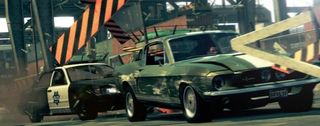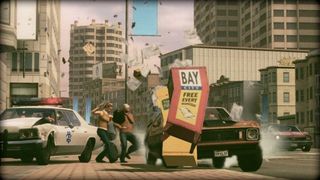Why Driver: San Francisco should win a Golden Joystick

With the Golden Joystick Awards just around the corner, we asked heroic PCG freelancer Chris Schilling who he thought should snag a coveted gong. Agree? Disagree? You should make your voice known by heading over to the Golden Joystick website before the vote closes on 22nd October. The winner will be announced on 26th October, but for now, it's over to Chris to convince you of Driver: San Francisco's charms.
It's a brilliantly barmy idea. Protagonist Jack Tanner is in a coma, a very special type of coma that allows his subconscious to float high above the streets of San Francisco before possessing any driver whose car he fancies. As high-concept pitches go, it's a cracker. Yet it was being used to revive a franchise at its lowest ebb; before Driver: San Francisco came out, many pegged this endearingly mad conceit as a very silly way to prop up an ailing series. And then Ubisoft released the game, and it turned out the naysayers were the silly ones.
A series that until then had taken itself very seriously was now revelling in its new-found ability to have fun. After all, the thrill of the chase can only be heightened by the ability to involve just about any vehicle in a pursuit. Losing your quarry? Zip into a faster car to catch up. Behind your rivals in a crucial race? Halt their progress by hitting them head-on with an Escalade. The beauty of Driver: San Francisco is that there's no prescribed way of doing things: in most missions you can simply spend your time creating vehicular havoc.

Reflections mines laudable variety from its one wonderful idea. In one side mission you've got to stick to back streets to avoid turning your twitchy client into a nervous wreck; in another, your objective is to scare a suspect half to death. Races, meanwhile, allow you to pull off what would be impossible elsewhere – here you can occupy all three places on the winner's podium.
Very rarely do you need to err on the side of caution: most of the time you're actively rewarded for dangerous driving. The handling, meanwhile, hits that perfect sweet spot between arcade responsiveness and sim authenticity. If occasionally you'll pull off outrageous manoeuvres a little too easily, that's entirely in keeping with the fantastical narrative, not to mention the skills of its hero: Tanner's a skilled wheelman, after all, even when unconscious.
Then again, hero perhaps isn't the right word for Ghost Tanner. The beauty of the Shift mechanic is that it allows you to behave disgracefully, and the often hysterical responses of your passengers only encourage you to do it more often. Indeed, the script is – no exaggeration – one of the year's finest, with a blackly comic streak a mile wide. Sure, most of the laughs come at the expense of the poor folk you terrorise with your wild driving, but it's a gag that never stops being funny.
Sure, the multiplayer game can get a little too chaotic to be anything more than a fleeting diversion, and it's the most bare-bones port you could wish to see, with little to differentiate the PC game from the console versions that were the clear development focus. But a game this consistently, riotously entertaining deserves some kind of award. A vote for anything else would be a vote against fun.
The biggest gaming news, reviews and hardware deals
Keep up to date with the most important stories and the best deals, as picked by the PC Gamer team.

Most Popular







